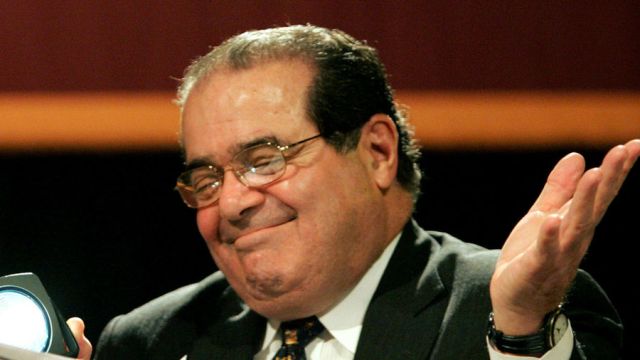It’s More Than Strange Politics. America Has a Serious Gun Fetish.

In 1968, as The Beatles were working on what would be known as “The White Album,” producer George Martin showed John Lennon a copy of the May 1968 issue of The American Rifleman he had found. Martin and Lennon read the title of Warren W. Herlihy’s feature, “Happiness Is a Warm Gun: Primer popping with pop from early boyhood,” with disbelief. “I thought it was a fantastic, insane thing to say,” Lennon later remarked. “A warm gun means you’ve just shot something.” Lennon, who would be assassinated by a gun by a mentally disturbed fan in New York City in 1980, turned that story into the song “Happiness Is a Warm Gun.” As Americans deal once again with the aftermath of the latest mass shooting, that song should be the musical accompaniment.
There are many sides to the gun debate (as the devoted commentators to this piece will no doubt point out; Welcome!), but all the rational arguments against guns (mainly based on ending the American “exceptionalism” regarding firearms in contrast to other developed countries such as Japan or Australia) eventually run into the wall of irrational fears and, to some degree, fetishes. It’s as if they can listen to Lennon sing, “Happiness is a warm gun mama/ When I hold you in my arms/ And I feel my finger on your trigger/ I know nobody can do me no harm,” but can’t hear the satire. Even the other Beatles crooning “Bang bang, shoot shoot” and “Oh, yeah” behind the lead vocal can’t clue them in to the caustic position Lennon’s making on the “fantastic, insane” gun fetish that commingles sex and gun violence into one dangerous, creepy brew.

Sex sells, of course. Almost all adult-targeted marketing’s based on that primal urge, so using sex to sell firearms is no surprise. What’s surprising (and disturbing) is the extent to which that marketing plan takes the imagery. For example, the UZI® PRO Pistol (a version of the Uzi weapon shown above) doesn’t need a female centerfold to hold it. It IS the centerfold. Glamour lighting and sleek packaging invite the target gun fetishist audience to take this weapon home for some special time. After describing the history of the Uzi, the marketing copy proudly announces that “the love affair with the world’s most iconic pistol continues today.” But it’s not just the Uzi that’s spawned love affairs, as this slideshow of the “13 hottest firearms for 2015” (which includes the UZI® PRO Pistol) will attest. Glock, Smith & Wesson, and other iconic gun names appear to offer all the deadly, efficient eye candy of the season. Clearly these are not for hunting, unless you’re hunting for a different kind of satisfaction than the challenges of the wilderness can offer.

If you want to see the ultimate image of gun fetishism with no filter on the sexual connotations, look no further than Rose McGowan’s Cherry Darling character in director Robert Rodriguez’s “Planet Terror” that was his contribution to the 2007 double-feature feature with Quentin Tarantino, Grindhouse. McGowan’s go-go dancer role goes dark when zombies tear off her right leg. After killing two rapists (one played by Tarantino himself) with her first prosthetic (a wooden table leg), Cherry upgrades to a machine gun prosthetic (shown in the movie poster above) that helps her kill the zombies. Rodriguez intentionally goes way over the top to recreate the feel of the classic 1970s exploitation film, but he also says something about the exploitation of sexuality to propagate the gun culture.
Gun shows prominently feature female models to show off the merchandise, just as car shows have done for decades. But cars lead to much fewer fatalities. If you want to see an even more obvious connection between guns and sex (and politics and special interest groups), check out Matt Haughey’s #GOPdildos, a very, VERY NSFW series of images in which Haughey photoshops guns out of the hands of Ted Cruz, Dick Cheney, Mitch McConnell, and other NRA-friendly figures and inserts sex toys for them to handle and gaze lovingly upon. You’ll never look at guns (or these politicians) the same way again.

I’ll confess to admiring the design of the modern firearm. They’re meant to please the eye. There’s a long tradition of craftsmanship in firearms. Go to any museum and you’ll see attractive weaponry of the past, such as the Queen Anne flintlock pistol (shown above). Britain’s Queen Anne only lent her name to the pistol designed during her reign in the early 18th century and didn’t carry one herself, but she could have, since the pistol was small enough to carry in a lady’s hand warmer muff, hence it’s other name — the muff pistol. We don’t have to muffle our appreciation for the form of the firearm and the craftsmanship behind it. However, we should be able to separate the form from the deadly function. There’s almost something ladylike about this flintlock versus the “hot” sex appeal of today’s weapons. If all we really want to do is look, then these weapons should be rendered unusable and turned into the safe, beautiful museum pieces they should be — either as symbols of today’s technological grace or as artifacts of yesterday’s brutal ways.

But if sexualized gun imagery is wrong, what might the “right” image of guns in America look like? I nominate sculptor Michael Murphy’s Gun Country (shown above). What makes Murphy’s Gun Country such an appropriate image for the gun debate is that when you see it straight on, it looks like a simple, two-dimensional picture, much like the way Second Amendment fundamentalists want the gun debate to look. Look closer and work your way around it (as the people in this video do) and you realize that it’s much more complex and multidimensional. Murphy hangs 130 toy guns at various depths that build up a map of the United States that is as layered and deceptively complex as the gun debate plaguing it.
Around 1.1 million Americans have died by firearms since Lennon’s assassination 35 years ago. The siren song of guns continues to drown out the message of “Happiness Is a Warm Gun.” Another Brit singer-songwriter, George Ezra, offered a new musical take on the gun fetish on his 2015 album Wanted on Voyage with the song “Stand by Your Gun,” which riffs off the romantic Country standard “Stand by Your Man.” “Go figure our true desires/ My darling, stand by your gun/ See we don’t need,/ No nothing more,/ We’re quite attached to the forty-four,” Ezra sings. Perhaps the real solution to the gun problem in America is, as Ezra suggests, to “figure our true desires” and analyze (maybe psychoanalyze) why the United States’ love affair with guns has become a commitment until death do we fall apart.
—





